

The Measurement and Modelling of DC and AC Streaming Potentials
The greatest understanding of the subsurface comes from the comparison of data from diverse sources or different physical properties. Occasionally apparently separate physical properties are physically coupled, and when that happens it is possible for us to predict one property from the other. The electro-kinetic and seismo-electro-kinetic phenomena are examples of such couplings that link the passage of seismo-acoustic vibrations, fluid flow and electrical flow in reservoir rocks.
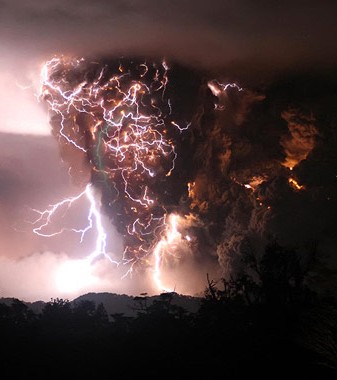 Although
not expressed here in rocks but in air instead, the electrical discharges
that occurred during the 2008 eruption of Chaìten, volcano, Chile are
based in electro-kinetic behaviour. The relative movement of charged dust
particles by advection and convection separates charge, which is then resolved
by the discharge of lightning.
Although
not expressed here in rocks but in air instead, the electrical discharges
that occurred during the 2008 eruption of Chaìten, volcano, Chile are
based in electro-kinetic behaviour. The relative movement of charged dust
particles by advection and convection separates charge, which is then resolved
by the discharge of lightning.
Electro-kinetic phenomena. A fluid flowing through a reservoir rock moves ions in such a way that an electrical potential difference is created, and an electrical current flows to restore the balance, or vice versa. If one knows the physics behind the coupling, one might in principle calculate the permeability of a rock from an electrical measurement without recourse to empirical data fitting. What is more, since electrical parameters may be measured remotely by self-potential, (magneto-)telluric and GPR techniques, these data may be interpreted as being caused by regional or local fluid flow in a reservoir or other permeable system. Already self-potential measurements have been used to map the convective flow of fluids around volcanoes using electro-kinetic coupling. The same approach can be used to monitor the depletion of a water-driven reservoir, or the flow of water into a potentially seismically active fault prior to an earthquake.
Seismo-electro-kinetic phenomena. Since the passage of a seismic wavelet implies local changes in fluid pressures and consequent fluid flow, the transport of seismo-acoustic energy through a rock is linked to fluid flow, and we may extend the electro-kinetic phenomenon to a seismo-electro-kinetic phenomenon. It is possible, in principle to perturb a layered earth with a seismic pulse, then to measure the resulting electrical signals as a function of offset. The so-called seismo-electric method relies on differences in the seismo-electro-kinetic coupling at interfaces in the subsurface and has recently been used to successfully image the vadose zone of a sand aquifer. Although several authors have recognised the potential of the method to provide direct access to rock properties such as porosity and permeability, little progress has been made. This is partly because the underlying physics of the seismo-electro-kinetic phenomena is not well described even though successful formulations for the DC regime have been available since Helmholz in 1879. However, recently there has been important progress in the AC formulation of the seismo-electro-kinetic phenomena that is necessary for use with the seismo-electric method and in the laboratory determination of the DC and AC coupling coefficients and associated zeta potential.
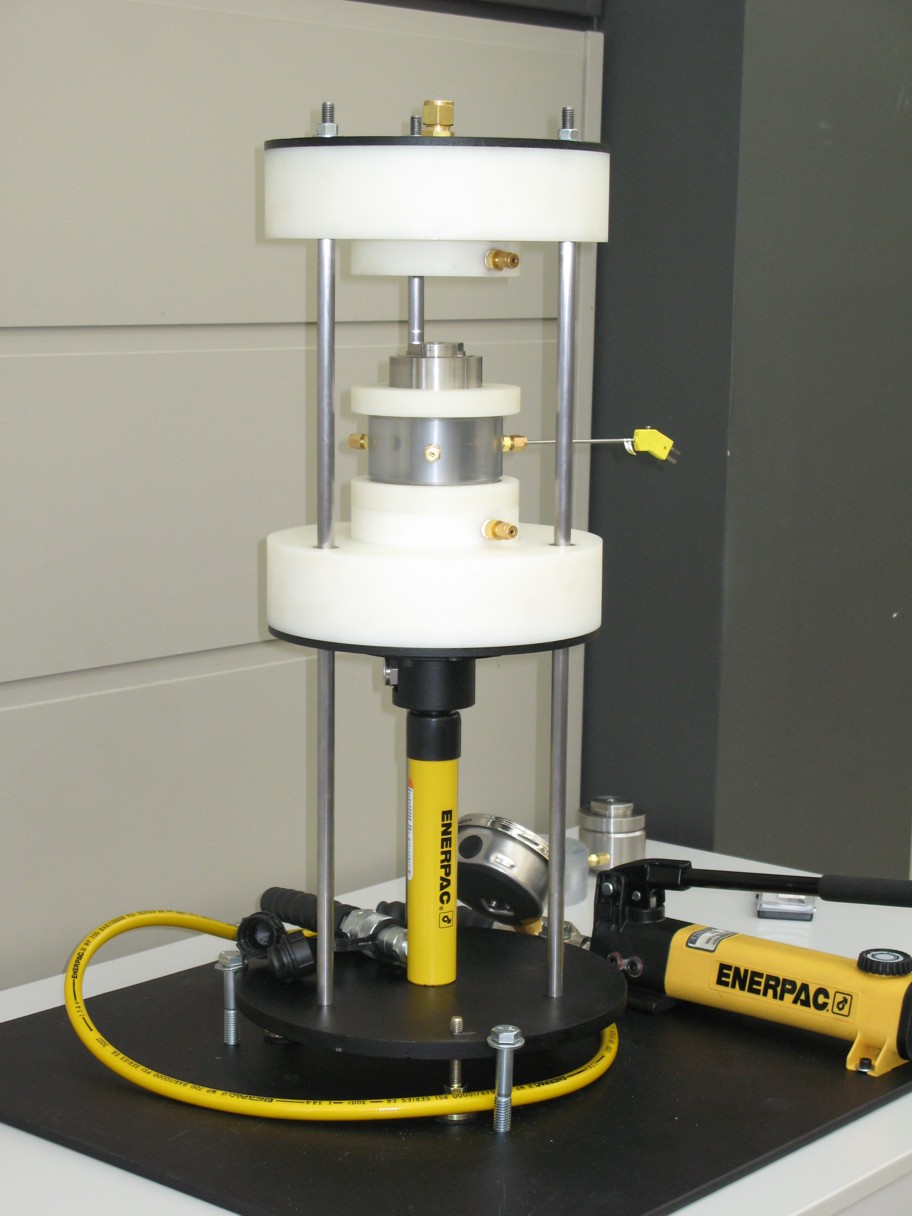
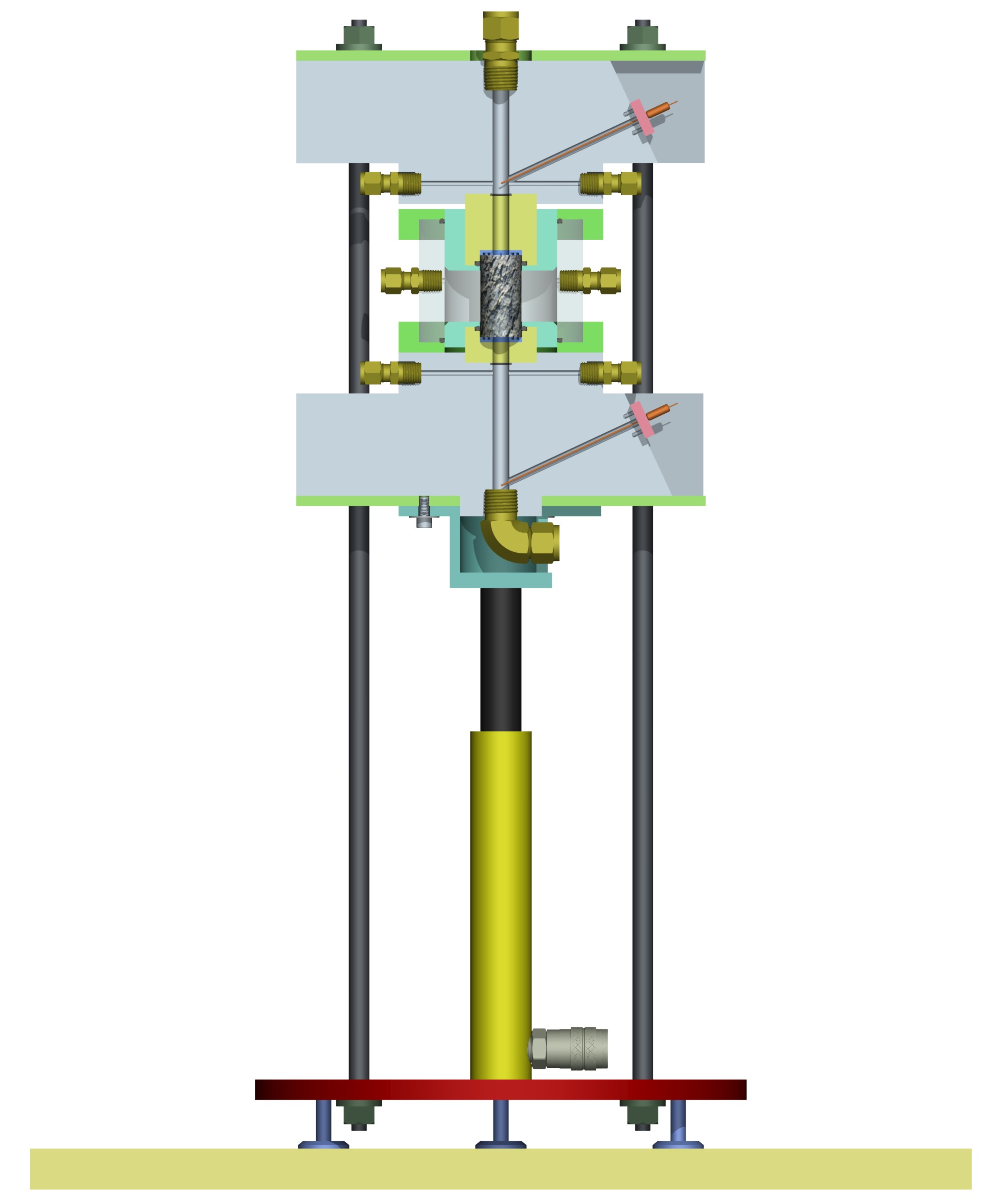
The new DC cell during development (left) and in cross-section (right).
Laboratory Development in the DC Regime. A new cell is being developed to allow the measurement of the complex electrical parameters and the streaming potential of sedimentary rocks and unconsolidated sands during the steady flow of fluid through the sample. The cell is based upon that of Laurence Jouniaux (EOPGS, Strasbourg) and is capable of taking cylindrical samples between 25 mm and 40 mm in diameter and 100 mm long with a sleeve pressure of 5 MPa and a maximum fluid pressure of 2.5 MPa. It is equipped with transducers to measure fluid pressure, fluid temperature, fluid pH, as well as non-polarising electrodes to measure the DC streaming potential and platinum blacked electrodes to measure the complex electrical properties of the rock samples.
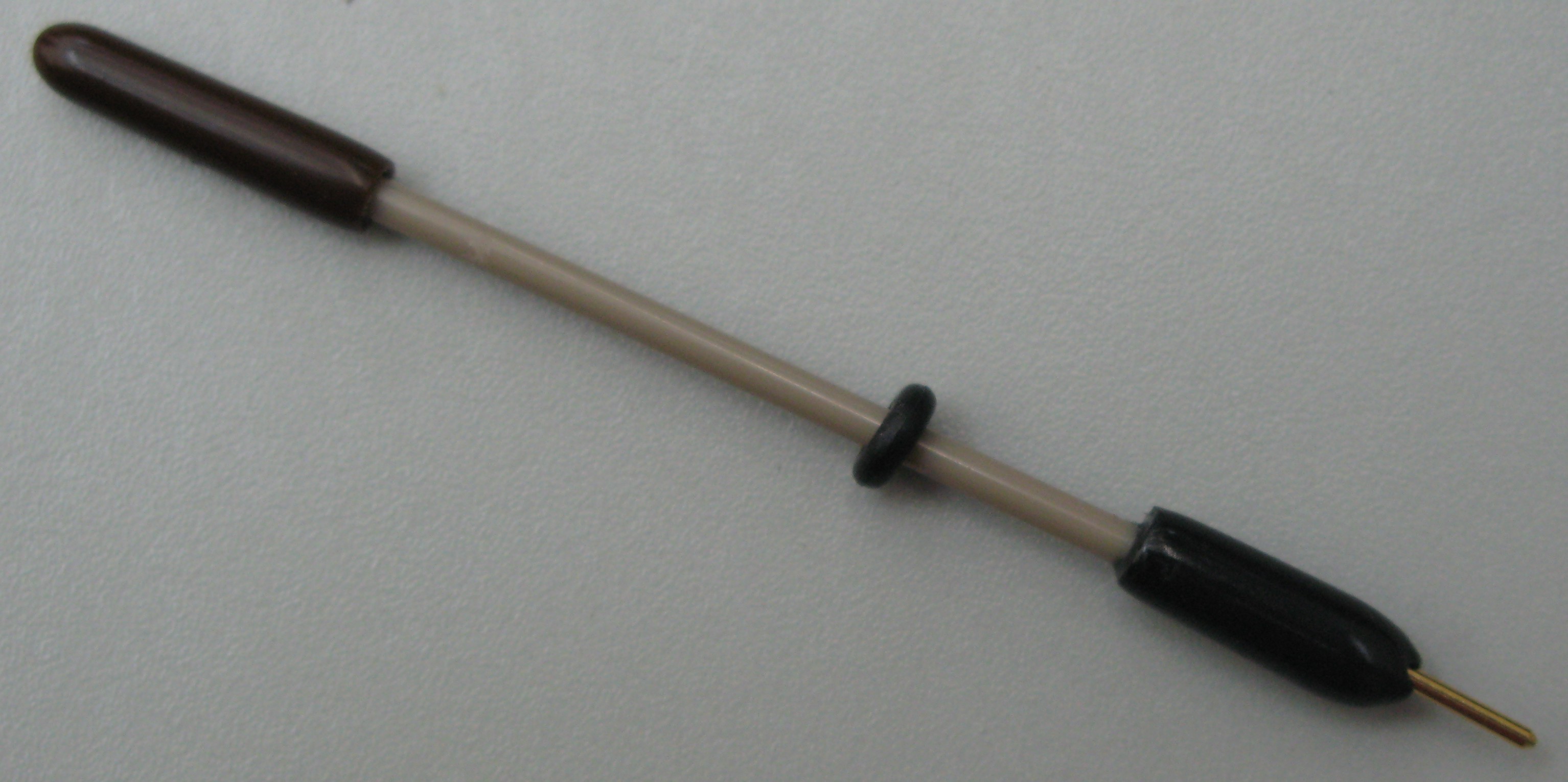
One of the non-polarising electrodes used in the new DC cell.
Laboratory Development in the AC Regime. A new cell is being developed to allow the measurement of the complex electrical parameters and the streaming potential of unconsolidated sands while a frequency dependent fluid flow is developed across a sample. The cell is designed as a perspex tube which can be loaded with the sample. Fluid can be flowed through the sample as a steady flow, as a slowly varying flow using a computer controlled pump, by using a high frequency piston that acts with a small travel on a membrane, and by using a high frequency piston with a long travel. In the latter two cases, the vibration is provided by a high precision industrial shaker. A mixture of pump-activated and shaker-activated flow is possible. Frequencies up to 5000 Hz are expected to be possible. The cell is equipped with high frequency pressure transducers and thermocouples as well as polarising and non-polarising electrodes to measure the AC streaming potential of the samples.
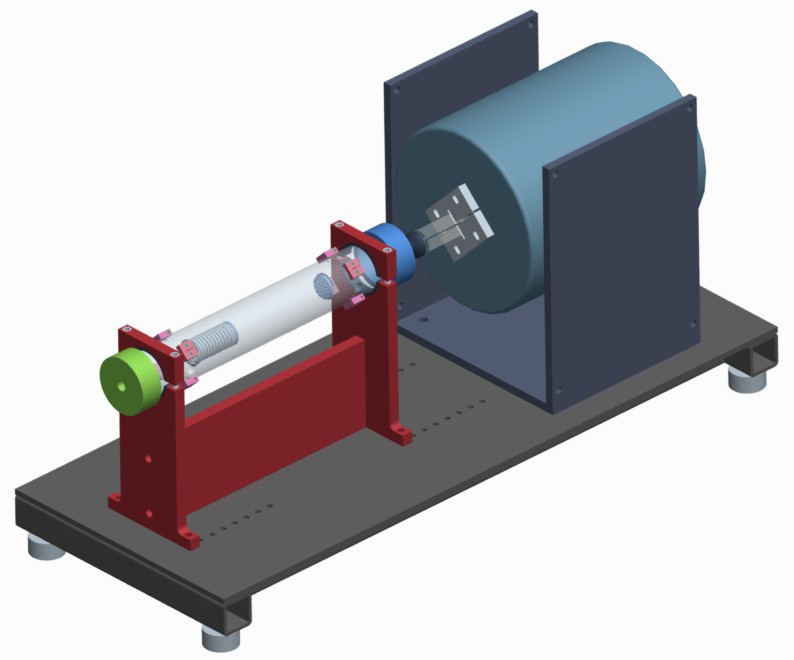
The design for the new AC streaming potential cell (left) and its physical reality during construction (below).
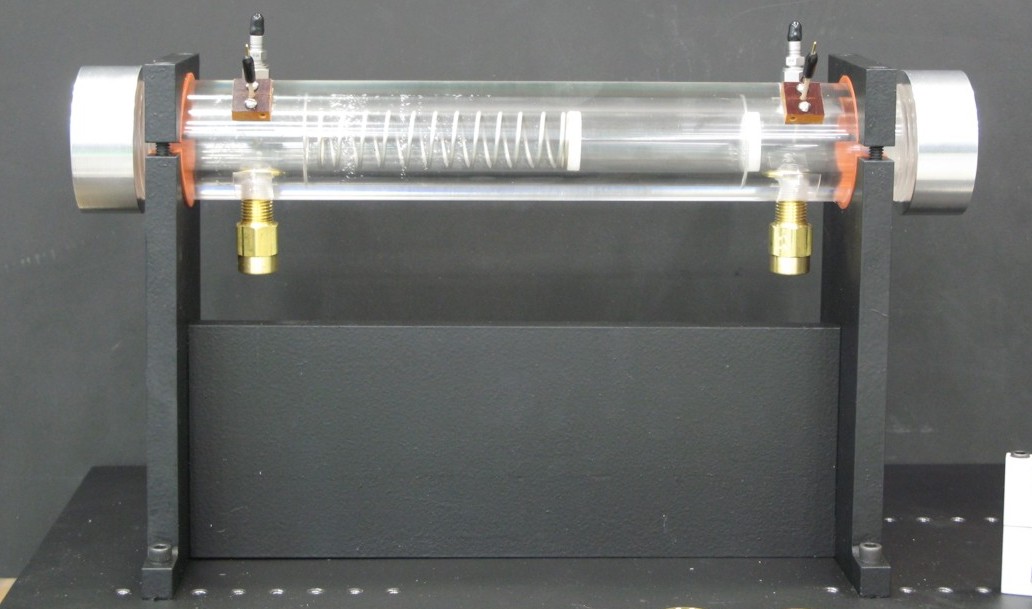
Modelling AC streaming potential and hydraulic coupling coefficients. In addition to the experimental measurements, we are also in the process of developing methods for modelling the AC streaming potential and hydraulic coupling coefficients of rocks. This work is at an early stage, but it is already clear that neither follow Cole and Cole or Debye dispersion types, unlike complex electrical conduction, and that the mixing laws for the hydraulic and the streaming potential coupling coefficients are completely different.

The normalised streaming potential (blue) and hydraulic coupling coefficients (red) for a porous rock with a characteristic pore throat size of 50 microns as a function of frequency. The closest fit Debye dispersion curve (green) is given for comparison.
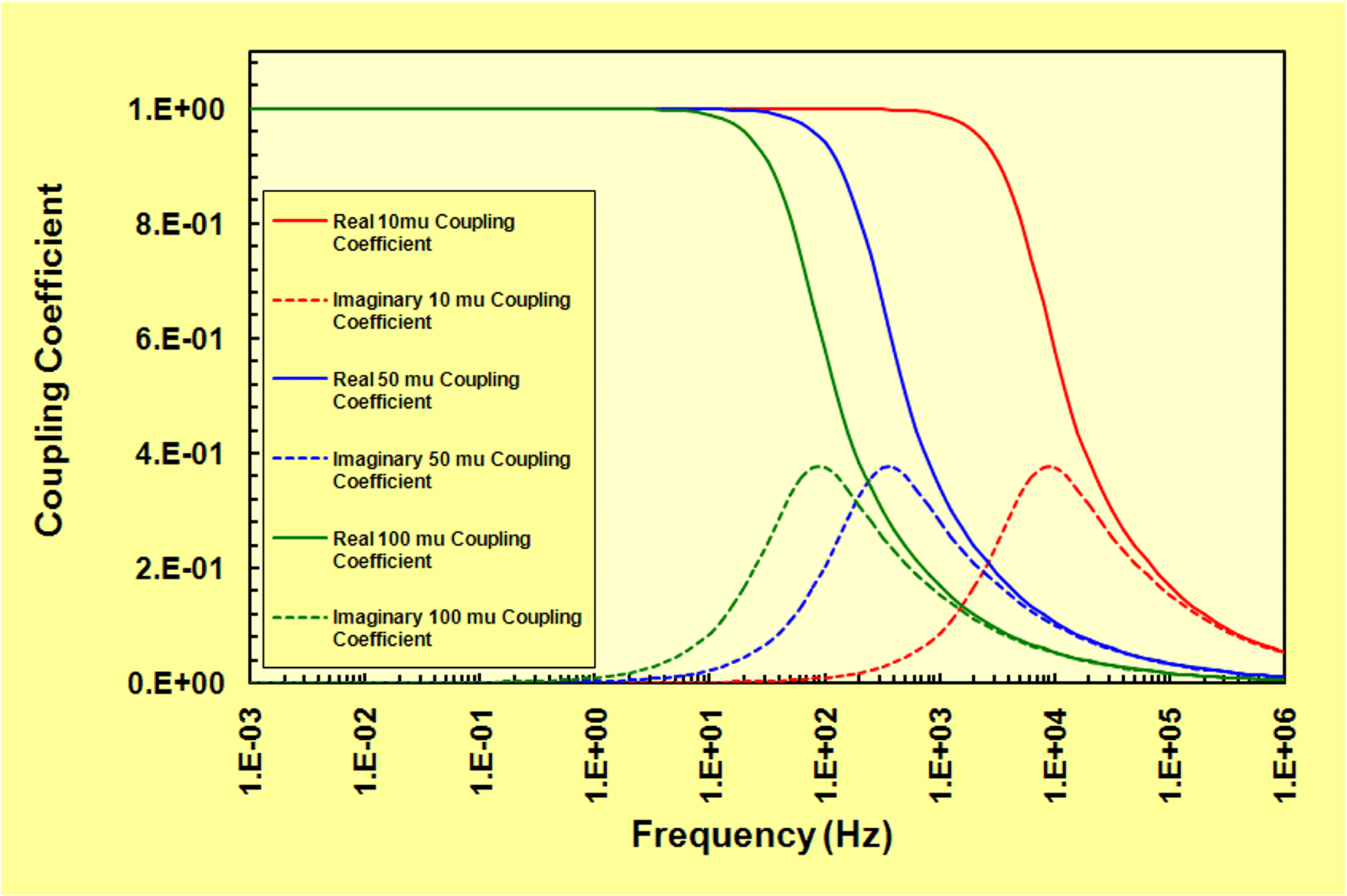
The normalised streaming potential coupling coefficients for a porous rocks with a characteristic pore throat sizes of 10, 50 and 100 microns as a function of frequency.
Bibliography
Walker, E.,Glover, P.W.J., Ruel, J., Hadjigeorgiou, J. & Lalande, G., An experimental cell for the measurement of DC streaming potentials, in preparation for Rev. Sci. Instr.
Walker, E., Glover, P.W.J., Ruel, J., Hadjigeorgiou, J. & Lalande, G., An experimental cell for the measurement of AC streaming potentials, in preparation for Rev. Sci. Instr.
Walker, E. & Glover, P.W.J., Dispositifs pour mesurer les propriétés électrocinétiques de roches en laboratoire, Poster, Journée des sciences de la Terre, JSTE 2008, 28 March 2008. [pdf]
Walker, E., Glover, P.W.J., Ruel, J., Lalande, G., Jodouin, M. & Hadjigeorgiou, J., A laboratory apparatus for measuring the frequency-dependent streaming potential coupling coefficient of porous rock samples, Oral, EGU 2008, EGU2008-A-02916, 13-18 April 2008. As oral [pdf] and as poster [pdf]
Glover, P.W.J. & Walker, E., Modelling the frequency dependence of hydraulic flow and streaming potential coupling coefficients in capillary bundles and porous rocks, Poster, EGU 2008, EGU2008-A-02892, 13-18 April 2008. [pdf]
Walker, E., Glover, P.W.J., Ruel, J., Lalande, G., Jodouin, M. & Hadjigeorgiou, J., Un dispositif pour mesurer le coefficient de couplage électrocinétique d'échantillons de roches poreuse en laboratoire, Oral, ACFAS 2008, 3-9 May 2008. [pdf]
Glover, P.W.J. & Walker, E., Modeling hydraulic flow and streaming potential coupling coefficients in capillary bundles and porous rocks as a function of frequency, Oral, GAC-MAC 2008, Résumé No. 61, 26-28 May 2008. [pdf]
Walker, E., Glover, P.W.J., Ruel, J., Lalande, G., Jodouin, M. & Hadjigeorgiou, J., A method for measuring the AC and DC streaming potential coupling coefficients of porous rock samples in the laboratory, Oral, GAC-MAC 2008, Résumé No. 62, 26-28 May 2008. [pdf]
Presentations
Glover, P.W.J., Measurements, modelling and applications of the electro-kinetic properties of rocks, Oral, Geodetic and Geophysical Research Institute, Hungarian Academy of Sciences, Sopron, Hungary, Invited Lecture as part of the GASTEM Lecture Tour 2009, 27 April 2009. [abstract] [presentation]
Glover, P.W.J., Measurements, modelling and applications of the electro-kinetic properties of rocks, Oral, University of Padua, Italy, Invited Lecture as part of the GASTEM Lecture Tour 2009, 29 April 2009. [abstract] [presentation]
Glover, P.W.J., Measurements, modelling and applications of the electro-kinetic properties of rocks, Oral, ETHZ, Zurich, Switzerland, Invited Lecture as part of the GASTEM Lecture Tour 2009, 12 or 13 May 2009. [abstract] [presentation]
Glover, P.W.J., Measurements, modelling and applications of the electro-kinetic properties of rocks, Oral, University of Strasbourg, France, Invited Lecture as part of the GASTEM Lecture Tour 2009, 11 May 2009. [abstract] [presentation]
Glover, P.W.J., Measurements, modelling and applications of the electro-kinetic properties of rocks, Oral, University of Paris II, France, Invited Lecture as part of the GASTEM Lecture Tour 2009, 19 May 2009. [abstract] [presentation]
Glover, P.W.J., Measurements, modelling and applications of the electro-kinetic properties of rocks, Oral, Imperial College of Science, Technology and Medicine, University of London, UK, Invited Lecture as part of the GASTEM Lecture Tour 2009, June/July 2009. [abstract] [presentation]
© Copyright, Paul Glover 2008, 2009: Last updated 03/03/2009